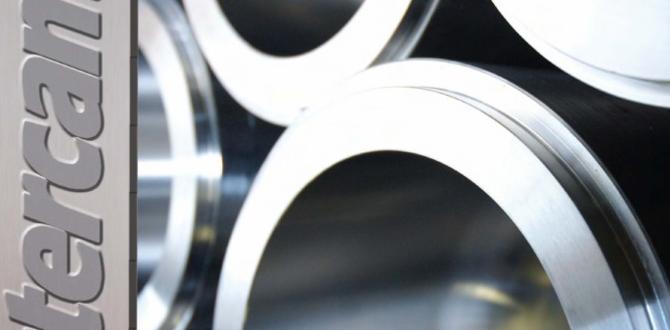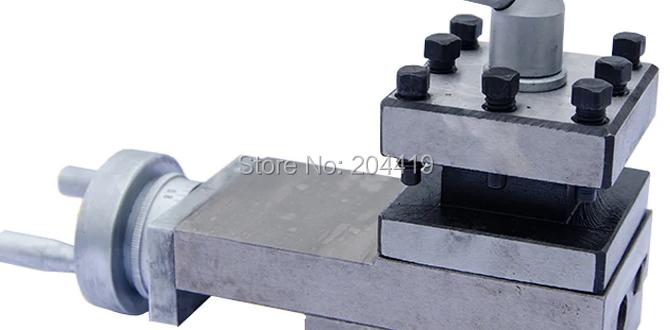A 1/8 inch carbide end mill with a 10mm shank and long reach is a fantastic tool for milling cast iron, helping significantly reduce chatter and achieve precise cuts. This guide will show you how to use it effectively.
Milling cast iron can sometimes feel like wrestling a stubborn, grumpy bear. You want smooth cuts, clean edges, and no horrible chattering noises echoing through your workshop, but often, you get the opposite. It’s frustrating, especially when you’re just starting out or trying a new material. But what if there was a way to make cast iron milling much more predictable and peaceful? There is! Using the right tool, like a specific type of 1/8 inch carbide end mill, can be a game-changer. We’re going to walk through how this small but mighty tool can help you achieve brilliant results on cast iron, making your machining tasks much smoother and more enjoyable. Ready to conquer cast iron? Let’s get started.
Mastering Cast Iron Milling with a 1/8 Inch Carbide End Mill
Cast iron might have a reputation for being tough, but with the right approach and tools, it’s a very workable material. For intricate details, tight profiling, and precise slotting in cast iron, a 1/8 inch carbide end mill, especially one designed for challenging materials and featuring a longer reach and a common 10mm shank for stability, can be your secret weapon. It’s not just about the size; it’s about the material of the tool and its specific design features that make it excel where other end mills might struggle.
Why Choose a 1/8 Inch Carbide End Mill for Cast Iron?
There are several reasons why this specific tool is a great choice for cast iron milling. Carbide, as a material, is significantly harder and can withstand higher temperatures than High-Speed Steel (HSS). This is crucial when machining cast iron, which can be abrasive and generate a fair amount of heat. The smaller diameter of 1/8 inch (approximately 3.175mm) allows for fine detail work, accessing confined areas, and precise material removal. When combined with features like a 10mm shank for rigidity and a long reach to get into deeper pockets, it becomes a versatile performer.
Benefits of Carbide for Machining
- Hardness: Carbide stays sharp longer, especially in abrasive materials like cast iron.
- Heat Resistance: It can handle the heat generated during cutting, leading to less tool wear and better surface finish.
- Rigidity: While the cutting edge is small, the inherent properties of carbide allow it to perform effectively when supported by a robust shank.
Advantages of a 10mm Shank Size
A 10mm shank is a common size that offers a good balance of rigidity and compatibility with standard collet systems. For a 1/8 inch cutting diameter, a 10mm shank provides substantial support, helping to prevent deflection and vibration, which are key contributors to chatter, especially in cast iron. This means more accurate cuts and a better finish on your workpiece.
The Importance of Long Reach
A long-reach end mill is essential when you need to mill into deeper features of your cast iron part. It allows the cutting tool to extend further from the tool holder, enabling access to areas that a standard-length end mill wouldn’t reach. However, using a longer reach does introduce more potential for deflection, so tool selection and machining parameters become even more critical to maintain accuracy and avoid chatter.
Understanding Cast Iron
Before we dive into the milling process, it’s helpful to understand what cast iron is. Cast iron is an iron-carbon alloy with a carbon content of over 2%. It’s known for its excellent castability, good compressive strength, and wear resistance. However, its microstructure, often containing graphite flakes or nodules, can make it somewhat abrasive and brittle.
Types of Cast Iron You Might Encounter
- Gray Cast Iron: Most common. Carbon exists as graphite flakes, which makes it easy to machine but can be abrasive.
- Ductile (Nodular) Iron: Graphite is in spherical nodules. It has higher tensile strength and ductility than gray iron, making it a bit tougher to machine but less abrasive.
- Malleable Iron: Made by heat-treating white iron. Has a more uniform graphite structure and offers good ductility.
- White Cast Iron: Very hard and brittle due to carbon being in carbide form. Difficult to machine and typically requires specialized tooling or grinding.
For most hobbyist and general machining applications, you’ll likely be working with Gray or Ductile Iron. The strategies discussed here are primarily aimed at these types.
Preparing to Mill Cast Iron with Your 1/8 Inch End Mill
Proper preparation is half the battle. Ensuring your machine, workpiece, and tool are set up correctly will lead to safer and more successful milling operations.
Machine Setup and Rigidity
Your milling machine needs to be in good condition. Any play in the ways, Z-axis, or spindle bearings will be amplified when milling cast iron, leading to poor surface finish and tool breakage. Ensure your machine is clean, lubricated, and that all gibs are adjusted correctly for a snug but free-moving operation.
Workholding is Key
Securing your cast iron workpiece firmly is paramount. Use sturdy vises, clamps, or other appropriate workholding methods. Any movement of the workpiece during the cut is a recipe for disaster, especially with a small end mill. For cast iron, ensure your clamping force is sufficient to prevent shifting but not so high that you crack the part, particularly if it has thin sections.
Tool Holder and Collet Selection
For a 1/8 inch end mill with a 10mm shank, a high-quality collet holder or a precision chuck is recommended. A rigid tool holder will minimize runout and vibrations. Ensure the collet fits the 10mm shank snugly and that the entire tool assembly is clean and free of debris. A clean taper on both the spindle and the tool holder is essential for accuracy and rigidity.
Step-by-Step Milling Process
Let’s break down the actual milling process into manageable steps. We’ll focus on achieving good results while minimizing chatter.
Step 1: Choosing the Right Speeds and Feeds
This is arguably the most critical part of milling cast iron. Incorrect speeds and feeds are the primary cause of chatter and tool failure.
Understanding Surface Speed (SFM) and Chipload
Surface Speed (SFM – Surface Feet per Minute): This refers to the speed at which the cutting edge of the tool moves past the workpiece material. For carbide tooling in cast iron, typical SFM ranges can be anywhere from 150 to 350 SFM, depending on the specific grade of carbide, the type of cast iron, and the coolant used. However, for a beginner and for a robust process that minimizes chatter, it’s often safer to start at the lower end.
Chipload: This is the thickness of the chip being removed by each cutting edge as the tool rotates. A proper chipload is essential. Too small, and you get rubbing and glazing (leading to heat and premature wear); too large, and you risk overloading the tool and machine.
Calculating Spindle Speed (RPM)
The spindle speed (RPM) is calculated using the desired surface speed and the diameter of the end mill:
RPM = (SFM × 12) / (π × Diameter)
Where:
- SFM is your target surface speed.
- 12 converts feet to inches.
- π (pi) is approximately 3.14159.
- Diameter is the cutting diameter of your end mill in inches.
Example Calculation: Let’s aim for 200 SFM with our 1/8 inch (0.125 inch) carbide end mill.
RPM = (200 × 12) / (3.14159 × 0.125) = 2400 / 0.39269 = ~6112 RPM
However, many hobbyist machines don’t reach such high RPMs. A more practical starting point on a machine capable of 3000-5000 RPM might involve adjusting the SFM downwards. For instance, if your machine’s max RPM is 4000, and you’re using the 1/8″ end mill:
SFM = (RPM × π × Diameter) / 12 = (4000 × 3.14159 × 0.125) / 12 = 1570.8 / 12 = ~131 SFM
This lower SFM is still within the usable range for carbide in cast iron, especially when prioritizing stability and chatter reduction over maximum metal removal rate.
For a 1/8 inch carbide end mill on cast iron, a good starting point for RPM on many benchtop machines might be between 2,000 to 4,000 RPM.
Calculating Feed Rate (IPM – Inches per Minute)
The feed rate is calculated based on your spindle RPM, the number of flutes on your end mill, and your target chipload. A reasonable chipload for a 1/8 inch carbide end mill in cast iron is around 0.001 to 0.003 inches per flute.
Feed Rate (IPM) = RPM × Number of Flutes × Chipload
Let’s assume a 4-flute end mill and a chipload of 0.002 inches per flute.
Feed Rate (IPM) = 3000 RPM × 4 flutes × 0.002 IPM/flute = 24 IPM
If you increase RPM to 4000:
Feed Rate (IPM) = 4000 RPM × 4 flutes × 0.002 IPM/flute = 32 IPM
It is generally better to run at a higher RPM with a lighter chipload than a lower RPM with a heavy chipload when trying to avoid chatter.
Step 2: Setting Up the Cut (Plunge, Climb, and Conventional Milling)
How the tool enters and moves through the material significantly impacts chatter and tool life.
Plunge Rate
When entering the material from above (plunging), especially in cast iron, do so at a slower feed rate than your cutting feed rate. A plunge rate of about 1/3 to 1/2 of your desired feed rate is a good starting point. Avoid plunging too fast, as this can shock the tool and the workpiece.
Climb Milling vs. Conventional Milling
- Climb Milling: The tool rotates in the same direction as its travel across the workpiece. This generally results in a better surface finish, less tool wear, reduced cutting forces, and crucially, it can help pull the workpiece material rather than push it, which can minimize deflection and chatter. This is often the preferred method for milling metals.
- Conventional Milling: The tool rotates against the direction of its travel. This typically results in higher cutting forces and can lead to more tool wear and a rougher finish. It’s often used when rigidity is a major issue or for tougher materials where climb milling might be too aggressive.
For cast iron with a 1/8 inch carbide end mill, climb milling is highly recommended to help counteract chatter and achieve a smoother finish.
Step 3: Making the Cut
Start with shallow depth-of-cuts and side-of-cuts. Cast iron can be brittle, and aggressive cuts can lead to chipping or breakage.
Depth of Cut (DOC)
For a 1/8 inch end mill in cast iron, start with a shallow DOC. Typically, 1/2 to 1 times the tool diameter is safe, but for cast iron and chatter reduction, starting even shallower is wise. Try 0.050 inches (1.27mm) or even 0.020 inches (0.5mm) for the first pass, especially if you’re unsure about your machine’s rigidity and your setup.
Step-over (Width of Cut)
The side-of-cut, or step-over, affects the load on the tool and the surface finish. Axial step-over refers to how much the tool is lowered for subsequent passes (depth of cut). Radial step-over refers to how much the tool moves sideways for each pass when profiling or pocketing. For cast iron, a typical radial step-over for profiling might be 40-60% of the tool diameter. For pocketing, you might use a larger step-over if a rougher finish is acceptable for the initial material removal, then a smaller step-over for a finishing pass.
Tip: If you hear chatter, try to slightly adjust your feed rate or spindle speed. Sometimes a small change can make a big difference. You might also consider using an “adaptive clearing” or “high-efficiency milling” strategy in your CAM software if you’re using one, as these are designed to maintain a consistent tool load and reduce chatter.
Step 4: Coolant and Lubrication
While some machinists dry-mill cast iron, using a coolant or lubricant can significantly improve tool life, surface finish, and chip evacuation. For cast iron, a soluble oil coolant or a flood coolant system works well. A jet of compressed air can also help clear chips and keep the cutting area cool.
Important Note: Always ensure proper ventilation and consider using an air blast with a filtration system when machining metals, as fine dust particles can be a health hazard. OSHA provides guidelines on machining safety, including dust control. You can find information on their website, www.osha.gov.
Step 5: Finishing Passes
Once you’ve removed the bulk of the material, it’s often beneficial to make a final finishing pass. For this, you’ll want to:
- Reduce the depth of cut (e.g., 0.010 inches or less).
- Reduce the feed rate slightly (e.g., 10-20% less).
- Ensure your cutting speed is appropriate.
This pass will clean up any tool marks and provide a smooth final surface finish.
Troubleshooting Common Problems
Even with careful preparation, you might run into issues. Here’s how to deal with them.
Chatter
Symptoms: A high-pitched ringing or vibration sound, rough surface finish, tool wear.
Causes: Insufficient rigidity (machine, tool, or workpiece), incorrect speeds/feeds, dull tool, excessive depth of cut, workpiece fixtures yielding.
Solutions:
- Increase spindle speed (RPM).
- Decrease feed rate.
- Reduce depth of cut.
- Use climb milling.
- Ensure all components are rigid and vibration-free.
- Check for tool runout.
- Consider a tool with a higher helix angle or a variable pitch end mill if chatter persists severely.
Tool Breakage
Symptoms: The end mill snaps during operation.
Causes: Trying to take too aggressive a cut (depth or feed), sudden impact (e.g., hitting a hard spot in the casting, plunging too fast), insufficient coolant, worn tool, tool deflection leading to overload.
Solutions:
- Reduce depth of cut and feed rate.
- Ensure proper speeds and feeds are used.
- Plunge at a slower, controlled rate.
- Check for any hard spots or inclusions you can’t see.
- Use adequate coolant/lubrication.
- Replace dull or worn tools immediately.
- Ensure the tool is correctly seated in the collet and holder.
Poor Surface Finish
Symptoms: Scaly, rough, or wavy surface instead of a smooth finish.
Causes: Chatter, dull tool, incorrect speeds/feeds, insufficient coolant, excessive chip recutting.
Solutions:
- Implement solutions for chatter.
- Use a sharp, new end mill.
- Optimize speeds and feeds.
- Ensure good chip evacuation away from the cutting zone.
- Use a finishing pass with a lighter depth of cut and a slightly adjusted feed rate.
Advanced Techniques & Considerations
Once you’re comfortable with the basics, you can explore more advanced concepts.
High-Efficiency Milling (HEM) / Adaptive Clearing
These strategies, often found in CAM software, keep the tool engaged with a consistent radial depth of cut (chip thinning) and a high axial depth of cut. This results in smoother tool engagement, less heat buildup, reduced chatter, and faster material removal. While requiring CAM







